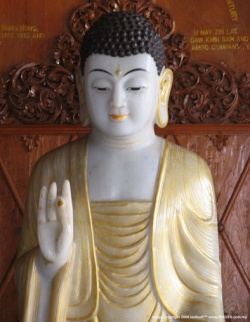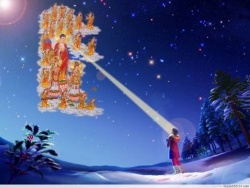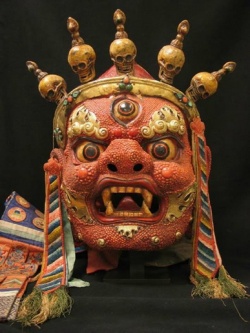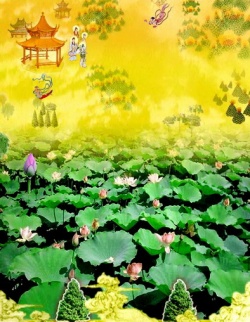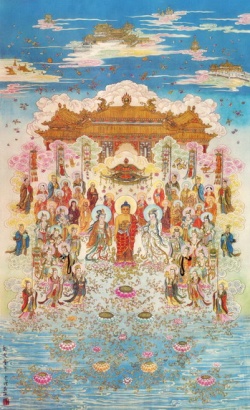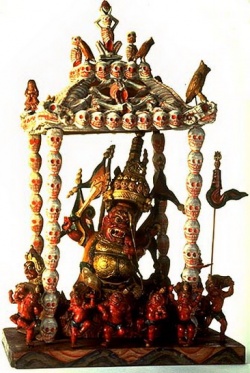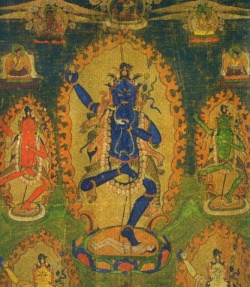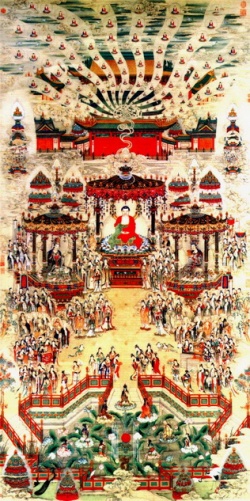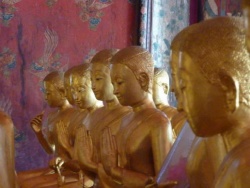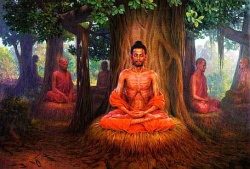Mahāsāṃghika
Mahāsāṃghika one of the earliest of the non-Mahāyāna Buddhist "sects" (the so-called Eighteen Schools of Hīnayāna Buddhism), the Mahāsāṃghika has been generally considered the precursor of Mahāyāna. However, although the Mahāsāṃghika and its subschools espoused many of the most radical views later attributed to the "Great Vehicle," other factors and early schools also contributed to the development of this movement.
The adherents of the self-styled ‘Majority Community’ or ‘Universal Assembly’, a school of Buddhism which originated in the schism with the Sthaviras that occured after the Second Council (see Council of Vaiśālī) and possibly just prior to the Third Council (see Council of Pāṭaliputra I). The
dispute that led to this schism seems to have largely concerned with interpretation of the Vinaya, in respect of which one side took a more liberal approach. A degree of doctrinal difference also seems to have been involved concerning disagreements over the nature of an Arhat (see Mahādeva).
This school went on to become one of the most sucessful and influential forms of Buddhism in India, giving rise to several subschools in later years such as the Ekavyāvahārika, the Lokottara-vāda, and the Bahuśrutīya. Some of the teachings of this school concerning the nature of Buddhas and Bodhisattvas have features in common with Mahāyāna concepts, but since there is no evidence of innovation by the Mahāsaṃghikas in this respect
before the rise of the Mahāyāna, in the view of some scholars, such elements should be ascribed to Mahāyāna influence. According to this view there is thus not much likelihood that the Mahāsaṃghika school played a part in the formation of the Mahāyāna before the latter emerged as a distinct entity. Other scholars see evidence for the converse in the formation of certain Mahāyāna sūtras, such as the Nirvāṇa Sūtra.
The Mahāsāṃghika (Sanskrit: महासांघिक mahāsāṃghika; traditional Chinese: 大眾部; pinyin: Dàzhòng Bù), literally the "Great Saṃgha," was one of the early Buddhist schools in ancient India.
One reason for the interest in the origins of the Mahāsāṃghika school is that their Vinaya recension appears in several ways to represent an older redaction overall. Many scholars also look to the Mahāsāṃghika branch for the initial development of Mahāyāna Buddhism.
Location
The original center of the Mahāsāṃghika sect was in Magadha, but they also maintained important centers such as in Mathura and Karli. The Gokulikas were situated in eastern India around Vārāṇasī and Pāṭaliputra. The Ekavyahāraka and Lokottaravāda subschools were found near Peshawar around 200
BCE, and the Bahuśrutīya in Kośala. The Caitika branch was based in the Āndhra region and especially at Amarāvati and Nāgārjunakoṇḍā. This Caitika branch included the Pūrvaśailas, Aparaśailas, Rājagirikas, and the Siddhārthikas. Finally, Madhyadesa was home to the Prajñaptivādins.
The cave temples at the Ajaṇṭā Caves, the Ellora Caves, and the Karla Caves are associated with the Mahāsāṃghikas.
Origins
Most sources place the origin of the Mahāsāṃghikas to the Second Buddhist council. Traditions regarding the Second Council are confusing and ambiguous, but it is agreed that the overall result was the first schism in the Saṃgha, between the Sthaviras and the Mahāsāṃghikas, although it is
not agreed upon by all what the cause of this split was. Andrew Skilton has suggested that the problems of contradictory accounts are solved by the Mahāsāṃghika Śāriputraparipṛcchā, which is the earliest surviving account of the schism. In this account, the council was convened at Pāṭaliputra over matters of
vinaya, and it is explained that the schism resulted from the majority (Mahāsaṃgha) refusing to accept the addition of rules to the Vinaya by the minority (Sthaviras). The Mahāsāṃghikas therefore saw the Sthaviras as being a breakaway group which was attempting to modify the original Vinaya.
Scholars have generally agreed that the matter of dispute was indeed a matter of vinaya, and have noted that the account of the Mahāsāṃghikas is bolstered by the vinaya texts themselves, as vinayas associated with the Sthaviras do contain more rules than those of the Mahāsāṃghika Vinaya. Modern scholarship therefore generally agrees that the Mahāsāṃghika Vinaya is the oldest. According to Skilton, future scholars may
determine that a study of the Mahāsāṃghika school will contribute to a better understanding of the early Dharma-Vinaya than the Theravāda school.
Appearance and Language
Appearance
Between 148 and 170 CE, the Parthian monk An Shigao came to China and translated a work which describes the color of monastic robes (Skt. kāṣāya) utitized in five major Indian Buddhist sects, called Da Biqiu Sanqian Weiyi (Ch. 大比丘三千威儀). Another text translated at a later date, the Śāriputraparipṛcchā, contains a very similar passage corroborating this information. In both sources, the Mahāsāṃghikas are described as
wearing yellow robes The relevant portion of the Śāriputraparipṛcchā reads, "The Mahāsāṃghika school diligently study the collected Sūtras and teach the true meaning, because they are the source and the center. They wear yellow robes."
According to Dudjom Rinpoche from the tradition of Tibetan Buddhism, the robes of fully ordained Mahāsāṃghika monastics were to be sewn out of more than seven sections, but no more than twenty-three sections. The symbols sewn on the robes were the endless knot (Skt. śrīvatsa) and the conch shell (Skt. śaṅkha), two of the Eight Auspicious Signs in Buddhism.
Language
The Tibetan historian Buton Rinchen Drub wrote that the Mahāsāṃghikas used Prākrit, the Sarvāstivādins used Sanskrit, the Sthaviravāda used Paiśācī, and the Saṃmatīya used Apabhraṃśa.
Doctrines and teachings.
Mundane and supramundane
The Mahāsāṃghikas held that the teachings of the Buddha were to be understood as having two principle levels of truth: a relative or conventional (Skt. saṃvṛti) truth, and the absolute or ultimate (Skt. paramārtha) truth. For the Mahāsāṃghika
branch of Buddhism, the final and ultimate meaning of the Buddha's teachings was "beyond words," and words were merely the conventional exposition of the Dharma. K. Venkata Ramanan writes:
The credit of having kept alive the emphasis on the ultimacy of the unconditioned reality by drawing attention to the non-substantiality of the basic elements of existence (dharma-śūnyatā) belongs to the Mahāsāṃghikas. Every branch of these clearly drew the distinction between the mundane and the ultimate, came to emphasize the non-ultimacy of the mundane and thus facilitated the fixing of attention on the ultimate.
Buddhas and bodhisattvas
The Mahāsāṃghikas advocated the transcendental and supramundane nature of the buddhas and bodhisattvas, and the fallibility of arhats. Of the 48 special theses attributed by the Samayabhedoparacanacakra to the Mahāsāṃghika, Ekavyāvahārika, Lokottaravāda, and the Gokulika, 20 concern the
supramundane nature of buddhas and bodhisattvas. According to the Samayabhedoparacanacakra, these four groups held that the Buddha is able to know all dharmas in a single moment of the mind. Yao Zhihua writes:
In their view, the Buddha is equipped with the following supernatural qualities: transcendence (lokottara), lack of defilements, all of his utterances preaching his teaching, expounding all his teachings in a single utterance, all of his sayings being true, his physical body being limitless, his
power (prabhāva) being limitless, the length of his life being limitless, never tiring of enlightening sentient beings and awakening pure faith in them, having no sleep or dreams, no pause in answering a question, and always in meditation (samādhi).
A doctrine ascribed to the Mahāsāṃghikas is, "The power of the tathāgatas is unlimited, and the life of the buddhas is unlimited." According to Guang Xing, two main aspects of the Buddha can be seen in Mahāsāṃghika teachings: the true Buddha who is omniscient and omnipotent, and the
manifested forms through which he liberates sentient beings through skillful means. For the Mahāsāṃghikas, the historical Gautama Buddha was one of these transformation bodies (Skt. nirmāṇakāya), while the essential real Buddha is equated with the Dharmakāya.
Like the Mahāyāna traditions, the Mahāsāṃghikas held the doctrine of the existence of many contemporaneous buddhas throughout the ten directions. In the Mahāsāṃghika Lokānuvartana Sūtra, it is stated, "The Buddha knows all the dharmas of the countless buddhas of the ten directions." It is also stated, "All buddhas have one body, the body of the Dharma."
The concept of many bodhisattvas simultaneously working toward buddhahood is also found among the Mahāsāṃghika tradition, and further evidence of this is given in the Samayabhedoparacanacakra, which describes the doctrines of the Mahāsāṃghikas. These two concepts of contemporaneous bodhisattvas and contemporaneous buddhas were linked in some traditions, and texts such as the Mahāprajñāpāramitā Śāstra use the
principle of contemporaneous bodhisattvas to demonstrate the necessity of contemporaneous buddhas throughout the ten directions. It is thought that the doctrine of contemporaneous buddhas was already old and well established by the time of early Mahāyāna texts such as the Aṣṭasāhasrikā Prajñāpāramitā Sūtra, due to the clear presumptions of this doctrine.
Manuscript collections
The Chinese Buddhist monk Xuanzang visited a Mahāsāṃghika-Lokottaravāda monastery in the 7th century CE, at Bamiyan, Afghanistan, and this monastery site has since been rediscovered by archaeologists. Birchbark and palm leaf manuscripts of texts in this monastery's collection, including
Mahāyāna sūtras, have been discovered at the site, and these are now located in the Schøyen Collection. Some manuscripts are in the Gāndhārī language and Kharoṣṭhī script, while others are in Sanskrit and written in forms of the Gupta script. Manuscripts and fragments that have survived from this monastery's collection include the following source texts:
Pratimokṣa Vibhaṅga of the Mahāsāṃghika-Lokottaravāda (MS 2382/269)
Mahāparinirvāṇa Sūtra, a sūtra from the Āgamas (MS 2179/44)
Caṃgī Sūtra, a sūtra from the Āgamas (MS 2376)
Vajracchedikā Prajñāpāramitā Sūtra, a Mahāyāna sūtra (MS 2385)
Bhaiṣajyaguru Sūtra, a Mahāyāna sūtra (MS 2385)
Śrīmālādevī Siṃhanāda Sūtra, a Mahāyāna sūtra (MS 2378)
Pravāraṇa Sūtra, a Mahāyāna sūtra (MS 2378)
Sarvadharmapravṛttinirdeśa Sūtra, a Mahāyāna sūtra (MS 2378)
Ajātaśatrukaukṛtyavinodana Sūtra, a Mahāyāna sūtra (MS 2378)
Śāriputra Abhidharma Śāstra (MS 2375/08)
Abhidharma
According to some sources, abhidharma was not accepted as canonical by the Mahāsāṃghika school. The Theravādin Dīpavaṃsa, for example, records that the Mahāsāṃghikas had no abhidharma. However, other sources indicate that there were such collections of abhidharma. During the early 5th century, the
Chinese pilgrim Faxian is said to have found a Mahāsāṃghika abhidharma at a monastery in Pāṭaliputra. When Xuanzang visited Dhānyakaṭaka, he wrote that the monks of this region were Mahāsāṃghikas, and mentions the Pūrvaśailas specifically. Near Dhānyakaṭaka, he met two
Mahāsāṃghika bhikṣus and studied Mahāsāṃghika abhidharma with them for several months, during which time they also studied various Mahāyāna śāstras together under Xuanzang's direction. On the basis of textual evidence as well as inscriptions at Nāgārjunakoṇḍā, Joseph Walser concludes that
at least some Mahāsāṃghika sects probably had an abhidharma collection, and that it likely contained five or six books.
Relationship to Mahāyāna.
Acceptance of Mahāyāna
In the 6th century CE, Paramārtha, a Buddhist monk from Ujjain in central India, wrote about a special affiliation of the Mahāsāṃghika school with the Mahāyāna tradition. He associates the initial composition and acceptance of Mahāyāna sūtras with the Mahāsāṃghika branch of Buddhism He states that 200 years after the parinirvāṇa of the Buddha, much of the Mahāsāṃghika school moved north of Rājagṛha, and were divided over whether the Mahāyāna
teachings should be incorporated formally into their Tripiṭaka. According to this account, they split into three groups based upon the relative manner and degree to which they accepted the authority of these Mahāyāna texts. Paramārtha states that the Gokulika sect did not accept the Mahāyāna sūtras as buddhavacana ("words of the Buddha"), while the Lokottaravāda sect and the Ekavyāvahārika sect did accept the Mahāyāna sūtras as buddhavacana.
Paramārtha also wrote about the origins of the Bahuśrutīya sect in connection with acceptance of Mahāyāna teachings. According to his account, the founder of the Bahuśrutīya sect was named Yājñavalkya. In Paramārtha's account, Yājñavalkya is said to have lived during the time of the Buddha, and to have heard his discourses, but was in a profound state of samādhi during the time of the Buddha's parinirvāṇa. After Yājñavalkya emerged from
this samādhi 200 years later, he discovered that the Mahāsāṃghikas were teaching only the superficial meaning of the sūtras, and therefore founded the Bahuśrutīya sect in order to expound the full meaning. According to Paramārtha, the Bahuśrutīya school was formed in order to fully embrace both "
conventional truth" and "ultimate truth." According to Sree Padma and Anthony Barber, the Bahuśrutīya understanding of this full exposition included the Mahāyāna teachings.
Prajñāpāramitā
A number of scholars have proposed that the Mahāyāna Prajñāpāramitā teachings were first developed by the Caitika subsect of the Mahāsāṃghikas. They believe that the Aṣṭasāhasrikā Prajñāpāramitā Sūtra originated amongst the southern Mahāsāṃghika schools of the Āndhra region, along the Kṛṣṇa River. These Mahāsāṃghikas had two famous monasteries near the Amarāvati and the Dhānyakaṭaka, which gave their names to the schools of the Pūrvaśailas and the
Aparaśailas. Each of these schools had a copy of the Aṣṭasāhasrikā Prajñāpāramitā Sūtra in Prakrit. Guang Xing also assesses the view of the Buddha given in the Aṣṭasāhasrikā Prajñāpāramitā Sūtra as being that of the Mahāsāṃghikas. Edward Conze estimates that this sūtra originated around 100 BCE.
Tathāgatagarbha
Brian Edward Brown, a specialist in Tathāgatagarbha doctrines, writes that it has been determined that the composition of the Śrīmālādevī Siṃhanāda Sūtra occurred during the Īkṣvāku Dynasty in the 3rd century CE, as a product of the Mahāsāṃghikas of the Āndhra region (i.e. the Caitika schools). Wayman has outlined eleven points of complete agreement between the Mahāsāṃghikas and the Śrīmālā, along with four major arguments for this association. Sree Padma and Anthony Barber also associate the earlier development of the Tathāgatagarbha Sūtra with the Mahāsāṃghikas, and conclude that the Mahāsāṃghikas of the Āndhra region were responsible for the inception of the Tathāgatagarbha doctrine.
Bodhisattva canons
Within the Mahāsāṃghika branch, the Bahuśrutīyas are said to have included a Bodhisattva Piṭaka in their canon, and Paramārtha wrote that the Bahuśrutīyas accepted both the Hīnayāna and Mahāyāna teachings. In the 6th century CE, Bhāvaviveka speaks of the Siddhārthikas using a Vidyādhāra Piṭaka, and the Pūrvaśailas and Aparaśailas both using a Bodhisattva Piṭaka, all implying collections of Mahāyāna texts within the Mahāsāṃghika
schools. During the same period, Avalokitavrata speaks of the Mahāsāṃghikas using a "Great Āgama Piṭaka," which is then associated with Mahāyāna sūtras such as the Prajñāparamitā and the Daśabhūmika Sūtra.
Views of scholars
According to A.K. Warder, it is "clearly" the case that the Mahāyāna teachings originally came from the Mahāsāṃghika branch of Buddhism. André Bareau has stated that there can be found Mahāyāna ontology prefigured in the Mahāsāṃghika schools, and has offered an array of evidence to support this conclusion. Bareau traces the origin of the Mahāyāna tradition to the older Mahāsāṃghika schools in regions such as Odisha, Kosala,
Koñkana, and so on. He then cites the Bahuśrutīyas and Prajñaptivādins as sub-sects of the Mahāsāṃghika that may have played an important role in bridging the flow of Mahāyāna teachings between the northern and southern Mahāsāṃghika traditions.
André Bareau also mentions that according to Xuanzang and Yijing in the 7th century CE, the Mahāsāṃghika schools had essentially disappeared, and instead these travelers found what they described as "Mahāyāna." The region occupied by the Mahāsāṃghika was then an important center for Mahāyāna Buddhism. Bareau has proposed that Mahāyāna grew out of the Mahāsāṃghika schools, and the members of the Mahāsāṃghika schools also accepted the teachings of the Mahāyāna.
Additionally, the extant Mahāsāṃghika Vinaya was originally procured by Faxian in the early 5th century CE at what he describes as a "Mahāyāna" monastery in Pāṭaliputra.
Vinaya Recension.
Early features
The Mahāsāṃghika Vinaya recension is essentially very similar to the other recensions, as they all are to each other. The Mahāsāṃghika recension differs most from the other recensions in structure, but the rules are generally identical in meaning, if the Vibhangas (explanations) are compared. The features of the Mahāsāṃghika Vinaya recension which suggest that it might be an older redaction are, in brief, these:
The Bhiksu-prakirnaka and Bhiksuni-prakirnaka and the Bhiksu-abhisamacarika-dharma sections of the Mahāsāṃghika Vinaya are generally equivalent to the Khandhakas/ Skandhakas of the Sthavira derived schools. However, their structure is simpler, and according to recent research by Clarke, the structure follows a matika (Matrix) which is also found embedded in the Vinayas of several of the Sthavira schools, suggesting that it is
presectarian. The sub-sections of the Prakirnaka sections are also titled pratisamyukta rather than Skandhaka / Khandhaka. Pratisamyukta / Patisamyutta means a section or chapter in a collection organised by subject; the 'samyukta-principle', like the Samyutta-Nikaya / Samyukta-agama.
Scholars such as Master Yin Shun, Choong Moon Keat, and Bhikkhu Sujato have argued that the Samyutta / Samyukta represents the earliest collection among the Nikayas / Agamas, and this may well imply that it is also the oldest organising principle too. (N.B. this does not necessarily say anything about the age of the contents).
There are also fewer stories in general in the Vinaya of the subsidiary school, the Mahāsāṃghika-Lokottaravāda, and many of them give the appearance of badly connected obvious interpolations, whereas in the structure of the Sthavira recensions the stories are integrated into the whole scheme. In the formulations of some of the pratimoksha rules also, the phrasing (though generally identical in meaning to the other recensions) often appears to represent a clearer but less streamlined
version, which suggests it might be older. This is particularly noticeable in the Bhiksuni-Vinaya, which has not been as well preserved as the Bhiksu-Vinaya in general in all the recensions. Yet the formulation of certain rules which seem very confused in the other recensions (e.g. Bhikkhuni Sanghadisesa three = six in the Ma-L) seems to better represent what would be expected of a root formulation which could lead to the variety of confused formulations we see (presumably later) in the
other recensions. The formulation of this rule (as an example) also reflects a semi-parallel formulation to a closely related rule for Bhiksus which is found in a more similar form in all the Vinayas (Pc64 in Pali).
Depiction of Devadatta
According to Reginald Ray, the Mahāsāṃghika Vinaya mentions the figure of Devadatta, but in a way that is different from the vinayas of the Sthavira branch. According to this study, the earliest vinaya material common to all sects simply depicts Devadatta as a Buddhist saint who wishes for the
monks to live a rigorous lifestyle. This has led Ray to regard the story of Devadatta as a legend produced by the Sthavira group. However, upon examining the same vinaya materials, Bhikkhu Sujato has written that the portrayals of Devadatta are largely consistent between the Mahāsāṃghika Vinaya and the
other vinayas, and that the supposed discrepancy is simply due to the minimalist literary style of the Mahāsāṃghika Vinaya. He also points to other parts of the Mahāsāṃghika Vinaya that clearly portray Devadatta as a villain, as well as similar portrayals that exist in the Lokottaravādin Mahāvastu.
Chinese translation
The Mahāsāṃghika Vinaya is extant in the Chinese Buddhist Canon as Mohesengzhi Lü (摩訶僧祗律; Taishō Tripiṭaka 1425). The vinaya was originally procured by Faxian in the early 5th century CE at a Mahāyāna monastery in Pāṭaliputra. This vinaya was then translated into Chinese as a joint effort between Faxian and Buddhabhadra in 416 CE, and the completed translation is 40 fascicles in length. According to Faxian, in Northern India, the
vinaya teachings were typically only passed down by tradition through word of mouth and memorization. For this reason, it was difficult for him to procure manuscripts of the vinayas that were used in India. The Mahāsāṃghika Vinaya was reputed to be the original vinaya from the lifetime of the Buddha, and "the most correct and complete."
Legacy
Although Faxian procured the Mahāsāṃghika Vinaya in India and had this translated into Chinese, the tradition of Chinese Buddhism eventually settled on the Dharmaguptaka Vinaya instead. At the time of Faxian, the Sarvāstivāda Vinaya was the most common vinaya tradition in China.
In the 7th century, Yijing wrote that in eastern China, most people followed the Dharmaguptaka Vinaya, while the Mahāsāṃghika Vinaya was used in earlier times in Guanzhong (the region around Chang'an), and that the Sarvāstivāda Vinaya was prominent in the Yangzi River area and further south. In
the 7th century, the existence of multiple Vinaya lineages throughout China was criticized by prominent Vinaya masters such as Yijing and Dao'an (654–717). In the early 8th century, Dao'an gained the support of Emperor Zhongzong of Tang, and an imperial edict was issued that the saṃgha in China should use only the Dharmaguptaka Vinaya for ordination.
Atisha was ordained in the Mahāsāṃghika lineage. However, because the Tibetan Emperor Ralpacan had decreed that only the Mūlasarvāstivāda order would be permitted in Tibet, he did not ordain anyone.
